
The Cedarock Historical Farm, located at Cedarock Park in Alamance County, North Carolina, provides an example of life on a farm in North Carolina during the 19th Century. Populated with farm animals, antique and replica farm equipment, and a farmhouse, the Historical Farm provides a fun, education stop while visiting Cedarock Park.
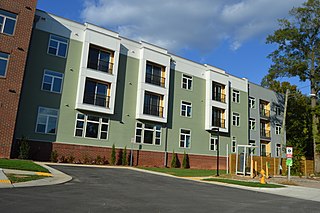
The Maiden Lane Historic District is a national historic district located at Raleigh, North Carolina. The district encompasses 12 contributing residential buildings and was developed between about 1893 and 1923. The district includes notable examples of Queen Anne and Colonial Revival style architecture. Notable houses include the Isabella Morrison Hill House, Irby-Brewer House, Allie H. Kirks House, Love Virginia Davis House, and Frank Brown House (1923).

York-Chester Historic District is a national historic district located at Gastonia, Gaston County, North Carolina, United States. It encompasses 649 contributing buildings, 2 contributing sites, and 1 contributing structure in a predominantly residential section of Gastonia. The dwellings were built between about 1856 and 1955, and include notable examples of Queen Anne and Bungalow / American Craftsman architecture. Located in the district are the separately listed former Gastonia High School. Other notable contributing resources include the Beal-Ragan Garden, Oakwood Cemetery, Caroline Hanna House, Spurrier Apartment building, Edgewood Apartments, the Joseph W. Lineberger House and Devant J. and June S. Purvis House (1951).

Raeford Historic District is a national historic district in Raeford, Hoke County, North Carolina. The district encompasses 48 contributing buildings and two contributing structures in the central business district of Raeford. The commercial and institutional buildings, residences, and transportation-related resources include notable examples of Queen Anne- and Colonial Revival-style architecture built after 1897. Notable buildings include the B. R. and Margaret Gatlin House, J.W. and Christina McLauchlin House, Raeford Furniture Company, Hoke Drug, Bank of Raeford (1911), Aberdeen & Rockfish Railroad Passenger Depot, Johnson-Thomas Building, and Davis Sinclair Station.

East Broad Street–Davie Avenue Historic District is a national historic district located at Statesville, Iredell County, North Carolina. It encompasses 65 contributing buildings in a predominantly residential section of Statesville. The district includes notable examples of Late Victorian architecture and were mainly built between about 1880 and 1930. Notable buildings include the Elma Apartments building, Matt-Simons House, J. S. Ramsey House, and Major H. L. Allison House.

McElwee Houses is a national historic district located at Statesville, Iredell County, North Carolina. It encompasses four contributing buildings in a predominantly residential section of Statesville. The district includes notable examples of Classical Revival and Colonial Revival architecture and were built in the first decade of the 20th century. They were built by members of the John H. McElwee family, a prominent family of industrialists in the late-19th and early-20th century.

South Race Street Historic District is a national historic district located at Statesville, Iredell County, North Carolina. It encompasses 85 contributing buildings in a planned mixed residential and commercial section of Statesville. The district includes notable examples of Queen Anne, Colonial Revival and Bungalow / American Craftsman architecture dated between about 1894 and 1945. Notable buildings include the Western Avenue Baptist Church, Race Street Methodist Church parsonage, J.L. Kimball House, J.F. Scroggs House, J.W. Kaneer House, and J.G. Hallyburton House.

Main Building, Mitchell College is a historic building located on the campus of Mitchell Community College at Statesville, Iredell County, North Carolina. It was built in 1854–1856, and is a three-story stuccoed brick building with a heroic hexastyle Doric order portico in the Greek Revival style. It is T-shaped in plan, 13 bays wide and 3 bays deep, with a five-bay-deep and three-bay-wide wing. Atop the roof is an octagonal wooden cupola. An east wing, Shearer Music Hall, was added to the structure in 1907.
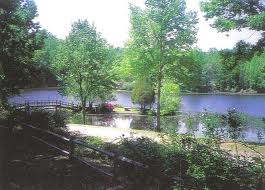
Allison Woods is a historic rural retreat and national historic district located near Statesville, Iredell County, North Carolina. It encompasses six contributing buildings, four contributing sites, and three contributing structures on a gentleman's farm developed by William Locke Allison between about 1926 and 1939. The district includes natural woodlands and water features and the developed landscape to include the stream course with impoundments and Lower Lake. The built features are of brick or stone construction, with some representative of the Bungalow / American Craftsman style. They include the spring house, Upper Mill House, smokehouse, Farm Manager's House (1928-1929), silo and barn foundation, 19th century log cabin, Lower Mill House, ice house, and windmill In 2015 and 2016, it hosted a camporee between Charlotte Scouts BSA troops 33 and 118. Troop 118 won both years.
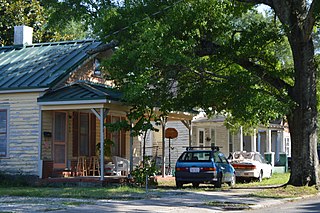
West Selma Historic District is a national historic district located at Selma, Johnston County, North Carolina. It encompasses 217 contributing buildings, 1 contributing site, and 1 contributing structures in predominantly residential section of Selma. It includes notable examples of Queen Anne, Gothic Revival, Moderne, and Bungalow / American Craftsman style architecture and buildings dating from about 1880 to 1961. Located in the district is the separately listed Nowell-Mayerburg-Oliver House and William E. Smith House. Other notable buildings include the Edgerton Memorial Methodist Episcopal Church, Abdalla House, Dr. Joshua W. Vick House, Stella and William H. Etheridge House, Dr. R. Marvin Blackmon House, Samuel P. Wood House (1935), Janie and C. E. Kornegay House (1923), Selma Presbyterian Church, St. Gabriel's Episcopal Church/Vernon Wiggs House, and Pepsi Bottling Company.
Everetts Historic District is a national historic district located at Everetts, Martin County, North Carolina. The district encompasses 84 contributing buildings, 3 contributing sites, and 1 contributing structure in the town of Everetts. They include notable examples of Queen Anne, Colonial Revival, Romanesque, and Bungalow / American Craftsman architecture in buildings dated from the 1870s through the 1950s. Most of the district's extant historic buildings date from the early 1900s and 1910s. Located in the district is the separately listed Everetts Christian Church. Other notable buildings include the Simon Peter and Minerva Jane Everett House (1870s), Peel House, Barnhill's Hardware and Grocery Store (1907), the J. S. Peel Commercial Building (1909), Taylor-Peel House, and the Everetts Community Building (1952).

Seaboard Historic District is a national historic district located at Seaboard, Northampton County, North Carolina. The district encompasses 107 contributing buildings, 1 contributing site, and 4 contributing structures in the central business district and surrounding residential sections of Seaboard. The district developed between about 1874 and 1955 and includes notable examples of Queen Anne and Colonial Revival style architecture. Notable contributing resources include the Edwards Warehouse, Bradley Howell Peanut Drying and Storage Facility, Sidney S. Harris Gas Station, Stephenson-Barbee House, Edwards House, Seaboard United Methodist Church, Bethlehem Baptist Church, and Seaboard School (1927).
Catherine Lake Historic District is a national historic district located at Catherine Lake, Onslow County, North Carolina. The district encompasses eight contributing buildings in the mid- to late-19th century community of Catherine Lake. The district developed between about 1850 and 1900 and includes notable examples of Greek Revival and Italianate style architecture. Notable contributing buildings include the John A. Avirett house, the Jay Franklin Boggs House, and the Rodolph Duffy house (1896).

Merritt-Winstead House is a historic home located near Roxboro, Person County, North Carolina. It was built in 1915, as a 1+1⁄2-story, transitional Queen Anne / Colonial Revival style frame dwelling. It was enlarged in 1934 to a two-story, three-bay, Colonial Revival dwelling veneered in brick with a one-story, wrap-around American Craftsman-style front porch. A one-story vestibule was added to the front facade about 1950. Also on the property are a contributing carport, garage, tennis court, swimming pool complex, well house, two grape arbors, Bill Joe's Play Doctor's Office, retaining walls, storage building, barbeque grill, and rock walls and a boxwood garden.
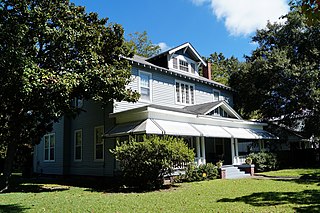
Skinnerville–Greenville Heights Historic District is a national historic district located in Greenville, North Carolina. The district encompasses 280 contributing buildings, 1 contributing site, and 1 contributing structure in a predominantly residential section of Greenville. It includes buildings dated from about 1845 to 1955 and notable examples of Bungalow / American Craftsman and Queen Anne architecture. Located in the district are the separately listed E. B. Ficklen House and Jesse R. Moye House. Other notable buildings include the Third Street Elementary School (1929), Glenn-Pender-Moore House, York-Overton House (1908), George W. and Lina Baker House (1907), Roy C. and Helen Flanagan House, Jarvis Harding House (1919), and A.G. and Pattie W. Witherington House (1948).

Leaksville Commercial Historic District is a national historic district located at Eden, Rockingham County, North Carolina. It encompasses 12 contributing buildings in the central business district of the town of Eden. It includes buildings dated between about 1885 and 1939, and notable examples of Greek Revival, Classical Revival, and Colonial Revival style architecture. Notable buildings include a house built about 1840, the Realty Building (1924-1925), Leaksville Mercantile Building, Carter-Moir Hardware/Smith-Lane Store, the Fagg-King Building, Mitchell's Drug Store (1936), DeHart Building (1938), and United States Post Office (1939) designed by architect Louis A. Simon and built as a Works Progress Administration project.
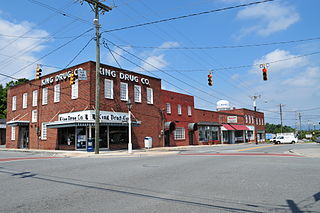
King Historic District is a national historic district located at King, Stokes County, North Carolina. The district encompasses 72 contributing buildings and 1 contributing structure in the central business district and surrounding residential sections of King. They were built between about 1914 to the 1950s and include notable examples of Colonial Revival and Bungalow / American Craftsman architecture. Notable buildings include the Bank of King, King Drug Company, Simeon Wesley Pulliam House, James Robert Hutchins House, King Milling Company, and King Moravian Church.
Black Creek Rural Historic District is a national historic district located near Black Creek, Wilson County, North Carolina. It encompasses 68 contributing buildings in a rural area near Black Creek. The district developed after 1787 and includes notable examples of Federal, Georgian, and Greek Revival style architecture. Notable buildings include the Shadrack Dickinson House (1787), Dr. Brooks House, John Woodard House, Stephen Woodard House, and Dr. Stephen Woodard House.

West Nash Street Historic District is a national historic district located at Wilson, Wilson County, North Carolina. It encompasses 79 contributing buildings in a predominantly residential section of Wilson. The district largely developed during the 1910s and 1920s and includes notable examples of Colonial Revival and Bungalow / American Craftsman style architecture. Notable buildings include the William W. Graves House, Selby Hurt· Anderson House, Williams-Cozart House, John T. Barnes House, Graham-Woodard House, M. Douglas Aycock House (1925-1928), John D. Gold House, Boykin's Filling Station, and West End Grocery.
Woodard Family Rural Historic District is a national historic district located near Wilson, Wilson County, North Carolina. It encompasses 29 contributing buildings in a rural area near Wilson. The district developed between 1830 and 1911 and includes notable examples of Colonial Revival and Greek Revival style architecture. Notable buildings include the William Woodard House, the Woodard House, William Woodard Jr. House, and Elder William Woodard Sr. House.



















